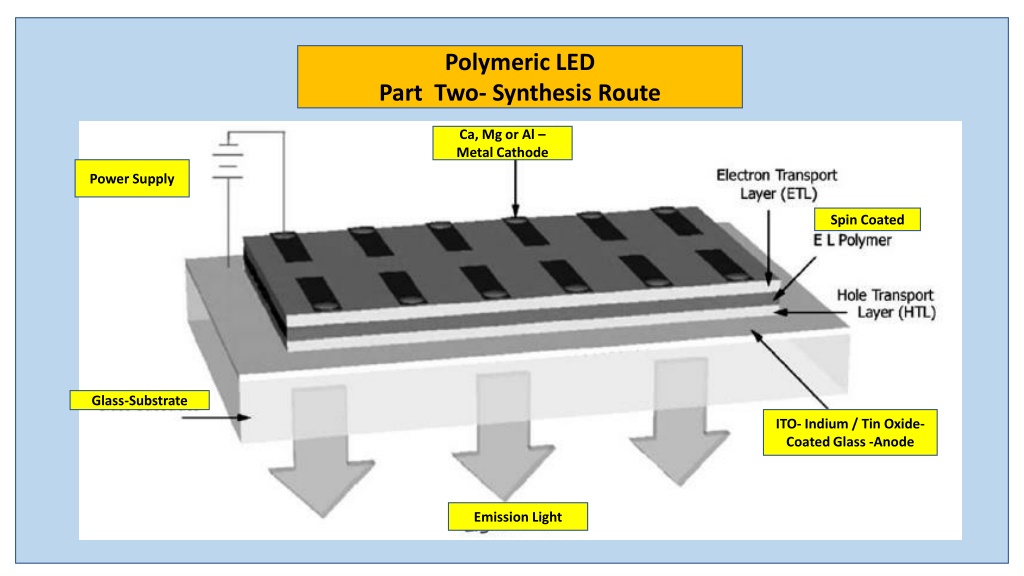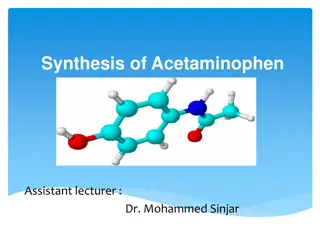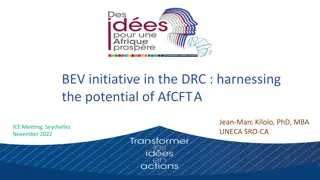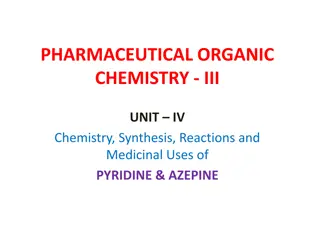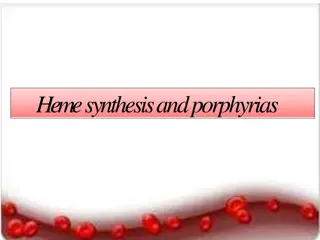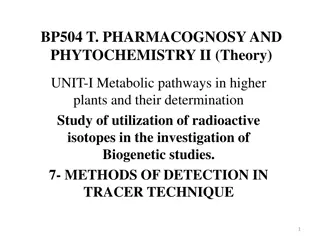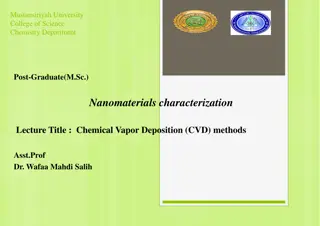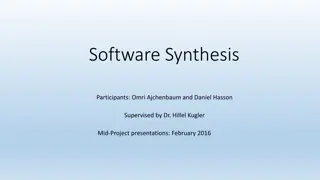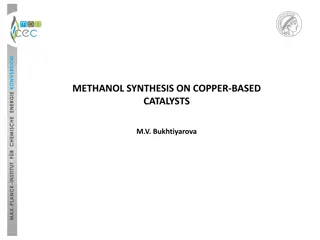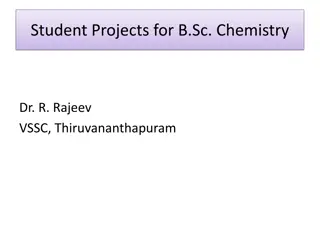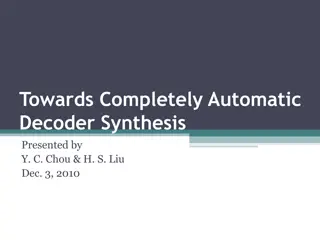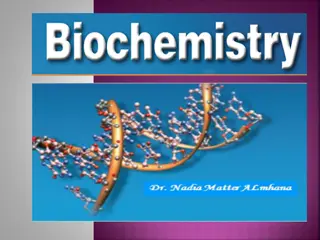Polymeric LED Synthesis Routes and Precursor Methods Explained
Explore the synthesis routes and precursor methods for polymeric LEDs, including the Wessling method, precursor routes to PPV, and the sulfur and chlorine precursor routes. Learn about the role of soluble polymers, thermal treatments, and the effects of side groups in the synthesis process.
Download Presentation

Please find below an Image/Link to download the presentation.
The content on the website is provided AS IS for your information and personal use only. It may not be sold, licensed, or shared on other websites without obtaining consent from the author. Download presentation by click this link. If you encounter any issues during the download, it is possible that the publisher has removed the file from their server.
E N D
Presentation Transcript
Polymeric LED Part Two- Synthesis Route Ca, Mg or Al Metal Cathode Power Supply Spin Coated Glass-Substrate ITO- Indium / Tin Oxide- Coated Glass -Anode Emission Light
1- The Wessling Method One of the most important soluble precursor routes to PPV was developed by Wessling and co-workers inthe 1960s [137,138] based upon aqueous solvent synthesis of poly( p-xylylene-a-dialkylsulfoniumhalides) from a,a0-bis(dialkyl sulfonium salts), followed by thermlytic formation of the final conjugated polymers as shown in Fig.1 Fig.The sulfonium precursor route (Wessling) to PPV. L. Akcelrud / Prog. Polym. Sci. 28 (2003) 875 962
Fig.2 Precursor route to PPV-containing randomly placed acetate and methoxy groups L. Akcelrud / Prog. Polym. Sci. 28 (2003) 875 962
Note: The precursor route involves the preparation of a soluble polymer intermediate that is cast in theappropriate substrate and after thermal treatment is converted to the final product in situ. This involves producing a polymer in which the arylene units are connected by ethylene units. The saturated units in the precursor contain a group which not only solubilizes the macromolecule and allows for processing, but also acts as a leaving group, thus affording the unsaturated vinylene units of a fully conjugated polymer. 2- The chlorine precursor route An important soluble precursor route for PPV and related polymers involves the polymerization of 1,4-bis(chloromethyl) (or bromomethyl) a renes by treatment with about one equivalent of potassium t-butoxide in non-hydroxylic solvents like tetrahydrofuran. This methodology was first used by Gilch and Wheelwright as one of the most successfully early PPV synthesis. Example.1 Cont.
CHA, cholestanoxy group Example.2
Example.3 Horhold and co-works elaborated fairly extensively on this methods and are applied it to synthesis of PPVs with large solubilization groups on the aryl ring such as cholestanoxy , high Mwt, highly phenylated PPVs.
3- The Sulfonium precursor route the sulfonium precursor route described has been more extensively used than the chlorine precursor methods. ?????. Why.
Effect of the side groups Note .1 It is a general trend that when electron donating alkoxy groups are attached to phenylene rings of PPVthe bandgap is reduced and the wavelength of the emitted light shifts to red from the green region Note .2 RO PPVs where the alkoxy RO length varied from C5 to C12 showed increasing EL intensity with increasing side chain length. This was attributed to the reductions of non-radiative decay processes due to preventing migration of excitons to traps Note.3 Halogenated derivatives of PPV as fluorine [203], chlorine, and bromine substituted PPVs showed a red-shifted emission in relation to observed .The red shift was assigned to the unsubstituted PPV. This contrasted with results for copolymers of PPV and tetrafluoro PPV, where a slight blue shift was electronic effects of fluorine aryl ring substitution and the blue shift to shortening of effective conjugation length. Electronic effect , Intramolecular packing , Side and type of alkyl or aryl groups which affect the 1- Emission color. 2- photoluminescence efficiency (PLeff).
BEH-PPV.has a close packing (due to its lateral symmetry) results in reduced PLeff, Polymers bearing bulky side groups show increased PLeff
4- Copolymers, conjugated-non conjugated system. So far we have seen that introducing substituents in the PPV molecule leads to various EL polymers, emitting in various regions of the visible spectrum according to their chemical structures. --- fully conjugated polymers may have chromophores with different energy gaps because the effective length of conjugation is statistically distributed.However, experimental work with oligomeric models led to the conclusion that the effective conjugation length of the solid polymer is not larger than 7 10 units , so To solve this problem several approaches have been developed. The confinement of the conjugation into a well-defined length of the chain is one of the most successful strategies developed so far. Copolymers in which a well-defined emitting unit is intercalated with non-emitting blocks have demonstrated that the emitted color was not affected by the length of the inert spacers but the EL efficiency of the single layer LEDs fabricated with the copolymers was a function of the length of the non-conjugated blocks; copolymers with longer spacers yielded higher efficiency devices. Those conjugated non-conjugated copolymers CNCPs) are soluble, homogeneous in terms of conjugation length, and can be designed to emit in any portion of the visible spectrum .
In such structures energy transfer from high band gap to lower band gap sequences in which excitons may partially confined will provide higher luminescence efficiency when compared to similar structures of uniform conjugation . It has been demonstrated, for example, that the random interruption of conjugation by saturated groups in the prototypical electroluminescent polymer poly(phenylene vinylene) (PPV) increased the devices efficiency by up to 30 times in relation to the corresponding PPV devices . Aliphatic spacer. PPV unite. . Wittig route to conjugated non-conjugated block copolymers (CNCPs) .
This method widely used route to CNCPs involves the Wittig type coupling of dialdehydes with bis(phosphoranylidene) schematically. This method was used to prepare a well-defined CNCP, having p-phenylene vinylene blocks intercalated by an aliphatic spacer which was the first blue soluble emitter at 465 nm. A series of CNCPs was prepared, varying the O(CH2)nO spacer length, and chromophore s structure (PPV type) and length allowing to correlate conjugation length with emission color and device efficiency. 1- Yang Z, Hu B, Karasz FE. Contributions of non conjugated spacers to properties of electroluminescent block copolymers. J Macromol Sci, Pure Appl Chem 1998;A35(2): 233 47. 2- Hu B, Yang Z, Karasz FE. Electroluminescence of pure poly(N-vinylcarbazole) and its blends with a multiblock copolymer. J Appl Phys 1994;76(4):2419 22.
---- The Wittig route (as with other condensation routes) does not lead to high molecular weight polymers because these become insoluble after a certain degree of polymerization is reached. In CNCPs the solubility provided by the spacer permits the obtainment of high molecular weight materials. ---- Structures combining chromophores in a linear fashion with non-conjugated spacers have been made, like the copolymers with the short spacer [ (CH2)3 ] and PPV units. In this case, it was necessary to attach flexible long alkoxy side groups or trimethyl silyl groups for solubility. Here the latter showed blue EL (470 nm) and a red shift was observed for the alkoxy substituted polymer --- Conjugation confinement can also be achieved by tailoring the polymer structure in other ways, like inserting kink (ortho and meta ) linkages or imposing steric distortions. Alkoxy substituted PPVs usually carry the alkoxy groups at the 2,5-positions in the ring and are red shifted in relation to unsubstituted PPV. Cacialli F, Chuah BS, Friend RH, Moratti SC, Holmes AB. Blue light-emitting diodes from a meta-linked 2,3 substituted alkoxy poly( p-phenylenevinylene). Synth Met 2000;111/ 112(1):155 8. By placing these substituents at the 2,3-positions and the ring in a meta-configuration it was possible to obtain blue emitting alkoxy-PPVs . The irregular chain structure with meta-linkages also reduces interchain interactions that often limit PL efficiencies through the effects of aggregation and excimer formation. Edwards A, Blumstengel S, Sokolik I, Yun H, Okamoto Y, Dornsinville R. Photoluminescence and electroluminescence of a soluble PPP-type polymer. Synth Met 1997; 84:639.
Polythiophene --- Among various polymers for LED fabrication poly(3-alkylthiophene) (PAT) ,has stimulated much interest because it was the first soluble and even fusible conducting polymer, and it demonstrated novel characteristics such thermochromism and solvatochromism. Garten F, Vrijmoeth J, Schatmann AR, Gill RE, Klapwijk TM, Hadziiiannou G. Light-emitting diodes based on polythiophene: influence of the metal workfunction on rectification properties. Synth Met 1996;76(1 3):85 9. -- EL in these materials was first reported by Ohmori and it is now possible to tune the emission of substituted polythiophenes from ultraviolet to IR by changing the substituent. Yoshino K, Love P, Onoda M, Sujimoto R. Dependence of absorption-spectra and solubility of poly(3-alkylthiophene) on molecular-structure of solvent. Jpn J Appl Phys: Part 2 1988;27(12):L2388 91.
4 2 3 1 5 3 5 1 4 2
Professor and Vice President of Research Carnegie Mellon University Office of Vice President for Research 5000 Forbes Ave. Warner Hall 608 Pittsburgh, PA 15213 rm5g@andrew.cmu.edu Possible regiochemical couplings of 3-alkylthiophene.
Cyanopolymers ---- The synthesis of polymers with high electron affinity as the solution processable poly (cyano terephthalydene)s which are derivatives of PPV with cyano groups attached to the vinylic carbons has provided the material necessary to complement the existing hole transport PPVs --- Poly (arylenevinylene) s bearing electron withdrawing groups are not easily available by application of the Wessling and related procedures and thus these cyano derivatives of PPV were synthesized via a Knoevenagel condensation route between an aromatic di acetonitrile and the corresponding aromatic dialdehyde Example .1 Knoevenagel Condensation
Condensation CO- Polymerization Wittig Route CNPs Q: What is the difference between electroluminescence and photoluminescent .
Note.1 The electron withdrawing effect of the cyano group is calculated to increase the binding energies of both occupied p and unoccupied pp states. Note.2 Copolymerization improves polymer solubility in volatile organic solvents and decreases crystallinity, improving the film forming properties, and also increases the band gap by confining conjugation. Note.3 Polymers having an octamethylene spacer between methoxy-PPV segments containing cyano groups in the double bond or in the 2,5-positions in the aromatic ring emitted an orange-red or yellow light, respectively, in contrast with a similar structure without the cyano group which emitted in the blue region.The observed bathochromic shift is due to the lowering of the conduction band ( LUMO ). Q: Write the starting material for the copolymers above, ( a,b,c and d ).
Thank you for your attention Dr.Widad .Salih
